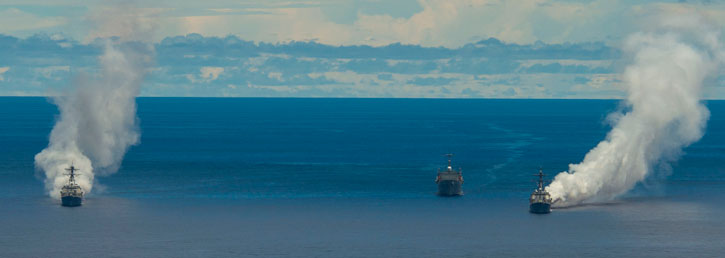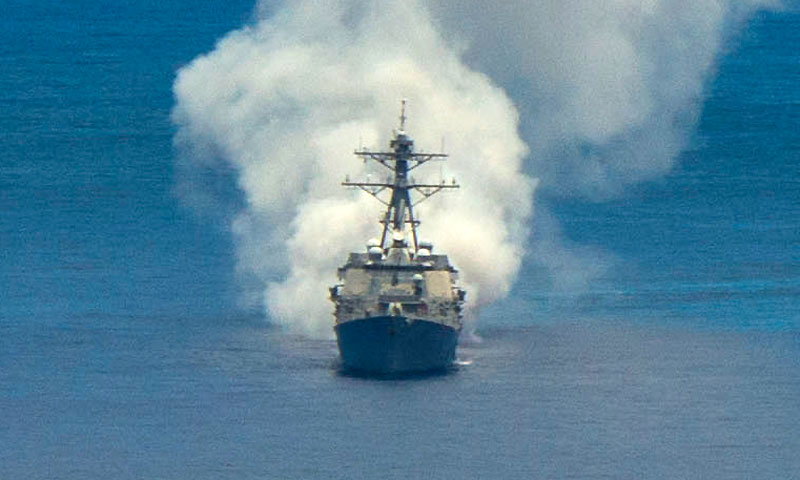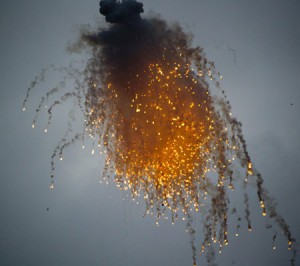| 美海军测试吸收雷达波碳纤维烟幕装置。 |
| 送交者: SDUSA 2014年06月28日22:05:11 于 [军事天地] 发送悄悄话 |
Carbon fiber clouds hiding naval destroyers from anti-ship missilesThe US Navy has tested radar absorbing carbon-fiber cloud generators on board ships, which could be used to protect naval vessels from attacks by radar-guided anti-ship and air-launched cruise missiles 
USS Mustin (DDG 89), USS Wayne E. Meyer (DDG 108) and USS Frank Cable (AS 40) test maritime obscurants held south of Guam to assess their tactical effectiveness for anti-ship missile defense. Note how the distribution of the cloud can be manipulated by the ship, under the same wind conditions, while the vessels maintain the same heading. (U.S. Navy photo, Timothy Wilson) The US Navy has recently tested a new anti-ship missile countermeasure system using an obscurant generator prototype. The systems and tactics were tested under a variety of at-sea conditions using assets from the U.S. Army, Navy, and Air Force to evaluate how radar-absorbing, carbon-fiber clouds can prevent a missile from detecting and striking its target as part of a layered defense. The Naval Warfare Development Command tested the maritime obscurant generator prototypes June 21-25 to assess their tactical effectiveness for anti-ship missile defense. The shipboard device generates carbon-fiber particles suspended in a cloud of smoke. These particles absorb and diffuse radar waves emanating from the seekers of incoming missiles, thus potentially obscuring the target from the missile’s seeker. 
During the ‘Pandarra Fog’ evaluation, the systems and tactics were tested under a variety of at-sea conditions using Seventh Fleet units and assets from the U.S. Army, Navy, and Air Force to evaluate how radar-absorbing, carbon-fiber clouds can prevent a missile from detecting and striking its target as part of a layered defense. Photo: US Navy, by Timothy Wilson. “Pandarra Fog showed the value of quickly bringing together scientific and joint forces to tackle our hardest warfighting problems. This isn’t just smoke or chaff, this is high tech obscurant, which can be effective against an array of missile homing systems,” said Antonio Siordia, U.S. Seventh Fleet’s science adviser. Vice Adm. Robert L. Thomas Jr., commander U.S. Seventh Fleet, kicked off the “Pandarra Fog”, the multi-ship experiment in Guam. “Pandarra Fog is example of the quick-turn integrated technical and tactical development the Fleet is doing to master electromagnetic maneuver warfare and assure access of joint forces,” Thomas said. The experiment demonstrated maritime obscurant generation can be a key enabler of offensive manoeuvre of the fleet despite the global proliferation of anti-ship cruise and ballistic missiles.
“We are developing a layered approach using a full spectrum of active and passive capabilities to give us the advantage. It is not just about the technology, but also practicing how the fleet will employ these emerging capabilities,” said Capt. David Adams, who leads the Seventh Fleet Warfighting Initiatives Group. “A defense in depth approach has a lot of advantages. Not only do we know the smoke is effective, it adds a level of uncertainty and unpredictability to the equation,” said Adams. 
Smoke screening is part of a multi-layered defense of surface vessels, which also includes active defense (air defense missiles), active decoys (jammers and RF decoys) chaff. The flares (seen in this photo) may be used for a last ditch defense, luring thermal seekers off target. In addition to having a significant level of effectiveness, the systems are relatively inexpensive when compared to othercountermeasures and can be tactically employed through typical fleet maneuvers. The materials are environmentally friendly and sized to maximize operational effectiveness. “Our initial assessment is the testing was very successful in terms of tactical employment, usability and cost-effectiveness,” said Adams.

The Japanese patrol boat Shiritaka (PG 829) fires a screen of flares on a naval display. On an operational deployment the flares create a screen of hot obscurant that can hide the vessel from incoming heat-seeking missiles. |
|
|
 |
 |
| 实用资讯 | |
|
|
| 一周点击热帖 | 更多>> |
| 一周回复热帖 |
| 历史上的今天:回复热帖 |
| 2013: | 台退役少将在对入伍新兵致辞:合久必分 | |
| 2013: | 美菲联合军演极力撇清“演习针对中国” | |
| 2012: | 专家:10万渔民民兵化 南海诸国均不是 | |
| 2012: | 菲佣外长表态:菲律宾永远不会将黄岩岛 | |
| 2011: | 看了《建党伟业》才知道中国比人家领先 | |
| 2011: | 俄难以置信:中国竟成功造出如此先进的 | |
| 2010: | 新华: 中国出手了—东海军演阻美韩舰队 | |
| 2010: | 选彭德怀参战朝鲜而非林彪---毛用心“ | |
| 2009: | 近千年的中国援朝历史说明援朝的目的是 | |
| 2009: | 二战中死的最冤枉的十支部队 | |




